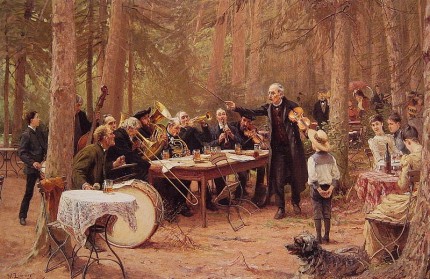CSO winds shine in Ravinia program
Members of the Chicago Symphony Orchestra winds performed a chamber music concert indoors at the Ravinia Festival’s Martin Theatre Tuesday night. But the program of works by Beethoven, Janacek, Richard Strauss and Dvorak conducted by Ravinia’s music director James Conlon was ideal for outdoor consumption. Amplified for listening outside the theater, the buoyant, gently sculpted serenades by Dvorak and Strauss, Beethoven’s E-flat Major Octet and Janacek’s Mladi (Youth) were perfect dinner music for picnickers scattered across Ravinia’s cool, misty grounds.
These are sizable chamber pieces. Janacek’s reminiscence of his boyhood home requires the smallest ensemble, a wind sextet. Strauss’s Serenade in E-flat Major, an early, beguiling work, calls for 13 players, and Dvorak’s familiar Serenade in D Minor, Op. 44, adds a cello and double bass to its contingent of 10 wind musicians. Throughout the evening, Conlon and his musicians—including such high-profile CSO players as Dale Clevenger, principal horn; Eugene Izotov, principal oboe; John Bruce Yeh, acting principal clarinet, and William Buchman, assistant principal bassoon—offered a combination of crisp phrasing and suave, seamless ensemble playing.
The opening work, Beethoven’s Octet, set the mood for the evening. There was a sense of sophistication combined with youthful high spirits in this piece, which was written in the early 1790s when Beethoven was still studying with Haydn. (Left unpublished for decades, its opus number was assigned later.) Izotov and Yeh exchanged musical ideas, tossing whirling phrases back and forth, while Yeh’s warm clarinet proved an amiable companion to Izotov’s clear, lithe oboe.
The darker harmonies, restless rhythms and sharply delineated instrumental voices of Janacek’s Mladi were a bracing change of pace. But Jennifer Gunn’s flute soared over the underlying bustle like a ray of sunshine, and Clevenger’s golden horn periodically emerged as a calming presence amid the boisterous crowd. When bass clarinetist J. Lawrie Bloom opened the second movement with a positively funereal solo, the five other musicians fell upon it like a pack of children teasing an overly somber friend. What began as a dirge became a romantic song and a syncopated dance.
Romance was at the core of Strauss’ Serenade, a work by a young composer with an old heart. The performance was full-bodied and luminous, though hints emerged of the lilting, windswept melodic voice that would become Strauss’ signature.
The evening closed with a rousing performance of Dvorak’s well-known Serenade. It was full of resolute, martial rhythms and folk-flavored melodies, but the rich tone and spontaneity that Conlon drew from the players had an elegant sheen. The third movement sounded more like a collection of individual voices than a cohesive unit, but the finale was full of fiery zest.
Posted in Performances


